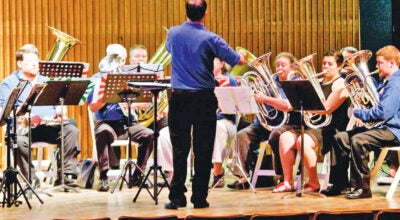Ohio’s bothersome, bad-to-the-bone bugs
Published 5:15 am Wednesday, June 8, 2022
All bugs serve a predestined purpose on the earth – right? Well, not in my flower garden or in my vegetable garden.
I grew up helping my grandmothers and mother in their gardens. And these country women prized their plants, but despised potato bugs and Japanese beetles, especially. When bad bugs destroyed crops, that meant less food for the rural family.
Ouch. The scratching from being bitten by bothersome chigger bugs was miserable during childhood. Scientists call these creatures “trombiculid mites.” They’re in the same family with spiders and ticks.
Being surrounded by animals in childhood meant an unending supply of fleas and flies. But the evening fireflies (lightning bugs) delighted country kids.
The following abysmal bugs taunt me and haunt me, when I let them. Nonetheless, perennial flowers will bloom again next year and there will be another veggie garden opportunity in 2023. I’m a backyard farmer.
Garden slugs. Ugh is the word. These slimy pests munch on my Hosta leaves and leave behind a slimy trail. Use a flashlight to find them at night and plop them in a cup of soapy water.
Japanese beetles. A mob devoured the leaves of my new hibiscus flowers last season and left a lacy skeleton pattern behind. Boo to Japanese beetle grubs because they feast on the roots of lawn grasses and garden plants. I pick the beetles off and also use a beetle bag.
Spider mites. Damage appears as small yellow or brown spots on the leaves of the plant.
Ladybug and lacewing insects feast on spider mites. Bon appétit. Beneficial bugs, please make dinner reservations in my garden.
Aphids. These sap-sucking insects are tiny pests that hide on the underside of leaves. Look for misshapen, curling, stunted or yellowing leaves. Some species include bean aphids, cabbage aphids, potato aphids, green peach aphids, melon aphids and woolly apple aphids. Yikes, that’s a lot of variety. Ladybugs, lacewings and parasitic wasps feed on aphids. Yummy.
Bagworms. I scan my trees on high alert for these snarly and nasty caterpillar webs. Yuck.
Stink bugs. The brown smelly marmorated stink bug is invasive to Ohio.
The spotted lanternfly was added to the invasive species list by Ohio Department of Agriculture. This flying moth-like pest loves to snack on and destroy grapes and apples. Praying Mantis invite lanternflies to seasonal barbeques.
A year ago, blaring cicadas swarmed parts of Ohio, but that won’t happen for another 17 years. Yay!
Several invasive insects are monitored and controlled by the Ohio Department of Agriculture, including the European gypsy moth, Asian long horned beetle, walnut twig beetle and the hemlock woolly adelgid.
My most abhorred Ohio insects are mosquitos, ticks, houseflies, fleas, roaches and bedbugs. Yucky.
Diseases that people can get from mosquitoes in Ohio include: West Nile virus, St. Louis encephalitis, La Crosse encephalitis, and Eastern equine encephalitis. Fight the Bite Ohio!
Watch the 2022 YouTube video “Garden Insects — The Bad, The Beneficial, and The Beautiful” at Christa’s Garden where she identifies tomato hornworm, cucumber beetle and assassin bug. She lives in Ohio.
Yay for the good-to-the-bone bugs. Kudos to the groovy garden gals and guys that gobble insects of iniquity.
Beneficial insects – the superhero bugs – feed on aphids, spider mites, leafhopper nymphs, thrips, ants and scales.
The green lacewing, an all-purpose garden champion, devours aphids, mealybugs, soft scale, whiteflies and the eggs of other insects such as spider mites and thrips. Hurray.
Other insects, such as spiders and praying mantids feed on both beneficial insects and pests.
In 1978, the first exhibit building devoted to insects in any U.S. zoo was built at the Cincinnati Zoo and Botanical Garden. Who knew?
I plant marigolds and sunflowers in the spring as they attract beneficial bugs that eat stink bug eggs and larva. Certain marigolds repel whiteflies and kill bad nematodes.
The Farmers’ Almanac lists ten insect-repelling plants: lavender, basil, thyme, mint, lemongrass, alliums, chrysanthemums, petunias, marigolds and mosquito plant.
Question: “What possible purpose do hornets, wasps, fleas and mosquitos serve?”
Answer: Retired Fernbank naturalist David Funderburk says it’s all about “pollination, predation, and parasitism.” Hornets and wasps pollinate flowers and eat aphids, caterpillars and other landscape pests.
Without wasps, there would be no Fig Newtons!
Mosquitoes (particularly the larvae) are important food for fish and amphibians. Fleas are food for small birds and soil-dwelling creatures.”
Funderburk goes on to proclaim, “There are no “good” and “bad” organisms. We just judge them based on whether or not an individual species or an individual organism makes a person’s life better or worse.”
While bad-to-the-bone bugs do make life worse, beneficial bugs make it better.
Melissa Martin, Ph.D., is a syndicated lifestyle, humorist and opinion-editorial columnist. She lives in Scioto County.





